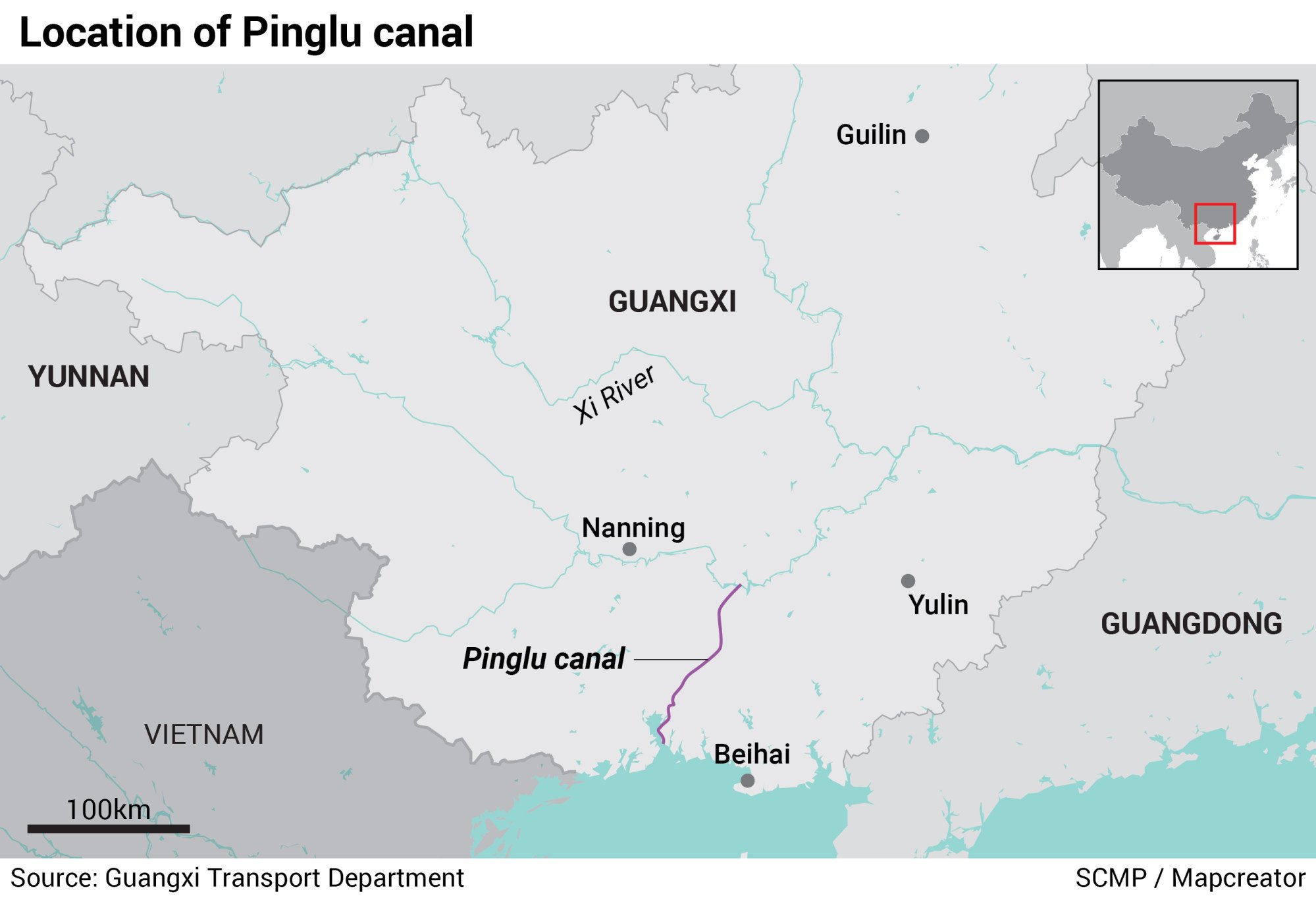
01:52
China launches mega US$10 billion canal project in a bid to help its economy
China’s highlights economy-boosting infrastructure push with mega US$10 billion canal project
- The 135km-long (84 miles) Pinglu Canal in the Guangxi Zhuang autonomous region will link up Xi River with ports in the Beibu Gulf
- Costing 72.73 billion yuan (US$10.5 billion), the project will take four and a half years to build as part of China’s renewed effort to use infrastructure to aid the economy
China kicked off the construction of a landmark 72.73 billion yuan (US$10.5 billion) canal in its southwest over the weekend as part of its latest efforts to use infrastructure to aid the distressed economy.
The 135km (84-mile) Pinglu Canal in the Guangxi Zhuang autonomous region is set to link up the Xi River with ports in the Beibu Gulf, also known as the Gulf of Tonkin.
Officially approved in March, the project was first brought up in the provincial government’s agenda in 2018, with construction set to last four and a half years.
“This year’s infrastructure construction has been accelerated significantly compared with the past few years, to stabilise growth,” said Larry Hu, chief China economist at Macquarie Group.

It will be China’s first new canal since 1949 and will provide a shorter route to the sea for inland areas in southwest China.
Local authorities, who said the waterway will be able to accommodate vessels of up to 5,000 tonnes, hope the canal will change the picture of transport and economic development in the region.
Even though Guangxi has invested heavily in its port constructions in recent years, with Beibu Gulf Port ranking as China’s 10th biggest last year in terms of cargo tonnage, water transport in the inland region currently needs to go through the neighbouring Guangdong province to reach the sea.
“[The provincial capital of] Nanning used to reach to the sea through the Xi and Pearl Rivers, but in the future, ships can save more than 560km by going through the Pinglu Canal,” Chen Hongqi, the party secretary of the provincial transportation department, told state broadcaster CCTV.
China announces US$44.7 billion for infrastructure projects to boost economy
According to the environmental impact assessment report, the canal will be mainly used for shipping coal, metal ore, cement, grain, mining and construction materials and containers.
The freight demand will reach 108 million tonnes and 130 million tonnes in 2035 and 2050, respectively, the report said.
Bordering Vietnam, Guangxi is considered a key hub for cooperation with countries in the Association of Southeast Asian Nations (Asean), with the canal set to serve as an important component in the transport network with China’s largest trading partner, industry experts said.
The construction will immediately drive a great demand for building materials, and once completed, will boost the local economy along the basin and help with the shift of manufacturing industries from Guangdong to southwest China, according to Peng Peng, executive chairman at the Guangdong Society of Reform, a Guangzhou-based think tank.
“It will also promote investment and cooperation between Guangxi, Guangdong and Asean countries,” Peng said.
Earlier this month, the Guangxi provincial financial department allocated 8 million yuan (US$1.2 million) to the Pinglu Canal Group – a newly-established state-owned entity that is in charge of the construction – as its first phase of registered capital.
The Guangxi branch of China Development Bank has also invested 7.27 billion yuan of infrastructure funds in the Pinglu Canal project – the largest ever single investment by Guangxi through a policy and development financial tool.
But it is unclear whether the subsequent economic benefits of the canal will pay off the large investment and environmental consequences, supply chain and environmental experts said.
The economic value of canal transport will be limited in China because now rail and road transport has been well developed
Guangxi has few advantageous industries compared to other regions, so it is uncertain how the project will help the region attract more capital, according to Liu Kaiming, head of the Institute of Contemporary Observation and a supply chain specialist.
“The economic value of canal transport will be limited in China because now rail and road transport has been well developed,” Liu said.
Xiong Yang, a Shenzhen-based environmental specialist, said artificial intervention in rivers will inevitably bring ecological problems, and the large investment is not cost-effective economically even for hinterland regions.
“The man-made canal is very different from natural rivers, and a lot of extra supporting infrastructure will be needed for the new water and land transportation network,” Xiong said.
China sets 1.94 trillion yuan bond record as Beijing returns to old playbook
The environmental impact assessment report said that the canal will go through five protection zones for drinking water sources, and occupy 849.18 hectares (2,098 acres) of farmland, 16.56 hectares of non-commercial forest and 13.9 hectares of wild mangrove forest, as well as having an impact on the aquatic ecosystem.
“Xi River is the main tributary of the Pearl River that flows across the Greater Bay Area, which is pivotal to China’s economy,” Xiong said, adding that Pearl River Delta is an area with a serious water shortage history.
“Any water conservancy project in the upper reaches of the Pearl River will directly affect the Pearl River Delta. If extreme weather occurs, the impact could be exacerbated.”



